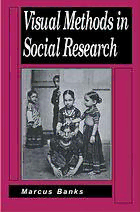
Visual methods in social research PDF
Preview Visual methods in social research
VISUAL METHODS IN SOCIAL RESEARCH VISUAL METHODS IN SOCIAL RESEARCH Marcus Banks SAGE Publications London • Thousand Oaks • New Delhi © Marcus Banks 2001 First published 2001 Apart from any fair dealing for the purposes of research or private study, or criticism or review, as permitted under the Copyright, Designs and Patents Act, 1988, this publication may be reproduced, stored or transmitted in any form, or by any means, only with the prior permission in writing of the publishers, or in the case of reprographic reproduction, in accordance with the terms of licences issued by the Copyright Licensing Agency. Inquiries concerning reproduction outside those terms should be sent to the publishers. SAGE Publications Ltd 6 Bonhill Street London EC2A 4PU SAGE Publications Inc. 2455 Teller Road Thousand Oaks, California 91320 SAGE Publications India Pvt Ltd 32, M-Block Market Greater Kailash – I New Delhi 110 048 British Library Cataloguing in Publication data A catalogue record for this book is available from the British Library. ISBN 0 7619 6363 4 ISBN 0 7619 6364 2 (pbk) Library of Congress catalog record available Typeset by Photoprint, Torquay, Devon Printed in Great Britain by Biddles Ltd, Guildford, Surrey Contents Preface ix Acknowledgements xiii Image credits xv 1 Reading pictures 1 1.1 The trouble with pictures 1 1.2 An introductory example 2 1.3 Unnatural vision 7 1.4 Reading narratives 9 2 Encountering the visual 13 2.1 On television 13 2.2 Visual forms produced I: representations of society 14 2.2.1 Interpreting Forest of Bliss 18 2.2.2 Still and moving images 22 2.3 Visual forms produced II: representations of knowledge 23 2.3.1 Diagrams of Nuer lineages 24 2.3.2 Diagrams of Indian caste 28 2.4 Visual forms encountered 33 2.4.1 Encountering indigenous media 34 2.4.2 The image as evidence 37 2.5 ‘Us’ and ‘them’? 42 3 Material vision 49 3.1 Object and representation 49 3.2 The materiality of visual forms 51 3.2.1 Displaying family photographs 54 3.3 Exchanged goods 56 3.3.1 Market exchange 57 3.4 Size matters 61 3.5 Transformations: digitization and computer-based media 62 3.5.1 Digital manipulation 64 vi VISUAL METHODS IN SOCIAL RESEARCH 3.5.2 Digital pornography: constraining the virtual 67 3.5.3 Digital pornography: exchange and circulation 68 4 Research strategies 73 4.1 Silk thread to plastic bags 73 4.2 Researching image use and production in social contexts 79 4.3 Watching television 80 4.3.1 Soap opera in India and Egypt 83 4.3.2 Television as a social presence 86 4.4 Doing things with photographs and films 87 4.4.1 Photo-elicitation with archival images 87 4.4.2 Photo-elicitation with contemporary images 90 4.4.3 Learning from photo-elicitation 94 4.4.4 Film-elicitation 96 4.5 Working with archival material 99 4.5.1 Photographic archives and picture libraries 100 4.5.2 Film archives 102 5 Making images 111 5.1 Observing 111 5.2 Creating images for research 112 5.3 Documentation 114 5.3.1 Documentary exploration 117 5.3.2 Documentary control 118 5.4 Collaborative projects 119 5.5 Indigenous media collaborations 122 5.5.1 Collaborative after-effects 127 5.6 Ethics 128 5.6.1 Permissions 131 5.6.2 Returning images 132 6 Presenting research results 139 6.1 Audiences 139 6.2 Presenting photographs 144 6.2.1 The photographic essay 145 6.3 Presenting ethnographic and other films 147 6.3.1 Study guides and other contextualization 149 6.4 Databases and digital images 151 6.4.1 Can computers see? 152 6.4.2 The HADDON Catalogue 155 6.5 Multimedia projects 161 6.5.1 Interacting with the Yanomamo¨ 164 6.6 Copyright 167 CONTENTS vii 7 Perspectives on visual research 175 7.1 The state of visual research 175 7.2 The place of visual research 177 7.3 The nature of visual research 178 Further resources 181 Bibliography 183 Filmography 195 Index 197 Preface This book aims to provide a brief account of some of the ways in which social scientists can incorporate visual images (of various kinds) into their research, together with a discussion of why they might wish to. The emphasis is very much on the use of visual materials as one among several research methods that may be employed by a social researcher during the course of an investigation, rather than a focus on the visual for its own sake. I assume that readers already have or are acquiring the skills to devise a research project that is valid within the context of their discipline, but may not have thought of adding a visual dimension. Those who are already experienced visual researchers and are seeking to add a sociological dimension to their work should probably look elsewhere, as they will probably find what I have to say basic or naive with regard to the visual and opaque or elliptical with regard to the sociological. While basic, and intended as a simple and practical guide for students, academic and non-academic researchers new to the fields of visual anthropology and visual sociology, this is not a technical guide to button- pressing on video cameras and the like. For that, readers should consult the technical manuals readily available in any large bookshop, in con- junction with a more specialist text written by and for social scientists. For film and video, Ilisa Barbash and Lucien Taylor’s Cross-Cultural Filmmaking (1997) is both encyclopaedic in its detail and authoritative in its commentary. For still photography, Terence Wright’s Photography handbook (1999) is a relatively short but practical text, shot through with historical, psychological and anthropological insight (Wright was a pro- fessional photographer before becoming an academic). Other relevant works are mentioned at various points in what follows. For computer- based multimedia, which I touch on in some places, there is no comparable text to Barbash and Taylor’s or Wright’s books, but I reference the few articles and other sources I have found useful where appropriate. A few more qualifications before going on. First, although I have tried to write this book for the generic social scientist I cannot hide the fact
